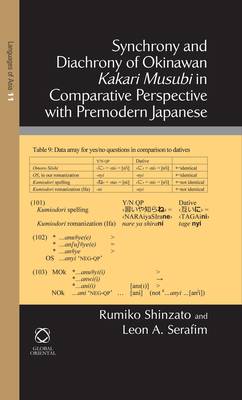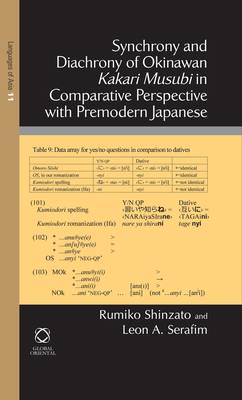
- Afhalen na 1 uur in een winkel met voorraad
- Gratis thuislevering in België vanaf € 30
- Ruim aanbod met 7 miljoen producten
- Afhalen na 1 uur in een winkel met voorraad
- Gratis thuislevering in België vanaf € 30
- Ruim aanbod met 7 miljoen producten
Zoeken
Synchrony and Diachrony of Okinawan Kakari Musubi in Comparative Perspective with Premodern Japanese
Rumiko Shinzato, Leon A Serafim
€ 264,45
+ 528 punten
Omschrijving
Rumiko Shinzato and Leon A. Serafim bring a new dimension to kakari musubi (a type of focus construction, henceforth KM) research, incorporating Japanese and Western linguistic theories, and synthesizing Okinawan and Japanese scholarship. Specifically, they analyze still-extant Okinawan KM in comparative perspective with its now extinct Japanese counterpart, while also offering reconstructed Proto-Japonic forms. Major hypotheses on the origins and demise of KM with insight from Okinawan are also evaluated.
In addition, viewing KM as consisting of kakari particle + nominalized musubi predicate, they compare KM with its structural analogs, such as (1) Modern Japanese no-da, (2) its corollary in Japanese Western Periphery dialects, and (3) English it-clefts.
Finally, the authors apply iconicity-based analyses and grammaticalization theory, interpreting correspondences between deictic-origin particles, which are shared, their epistemically unique musubi forms, and their respective functions.
In addition, viewing KM as consisting of kakari particle + nominalized musubi predicate, they compare KM with its structural analogs, such as (1) Modern Japanese no-da, (2) its corollary in Japanese Western Periphery dialects, and (3) English it-clefts.
Finally, the authors apply iconicity-based analyses and grammaticalization theory, interpreting correspondences between deictic-origin particles, which are shared, their epistemically unique musubi forms, and their respective functions.
Specificaties
Betrokkenen
- Auteur(s):
- Uitgeverij:
Inhoud
- Aantal bladzijden:
- 19
- Taal:
- Engels
- Reeks:
- Reeksnummer:
- nr. 11
Eigenschappen
- Productcode (EAN):
- 9789004219021
- Verschijningsdatum:
- 29/05/2013
- Uitvoering:
- Hardcover
- Formaat:
- Genaaid
- Gewicht:
- 561 g

Alleen bij Standaard Boekhandel
+ 528 punten op je klantenkaart van Standaard Boekhandel
Beoordelingen
We publiceren alleen reviews die voldoen aan de voorwaarden voor reviews. Bekijk onze voorwaarden voor reviews.








